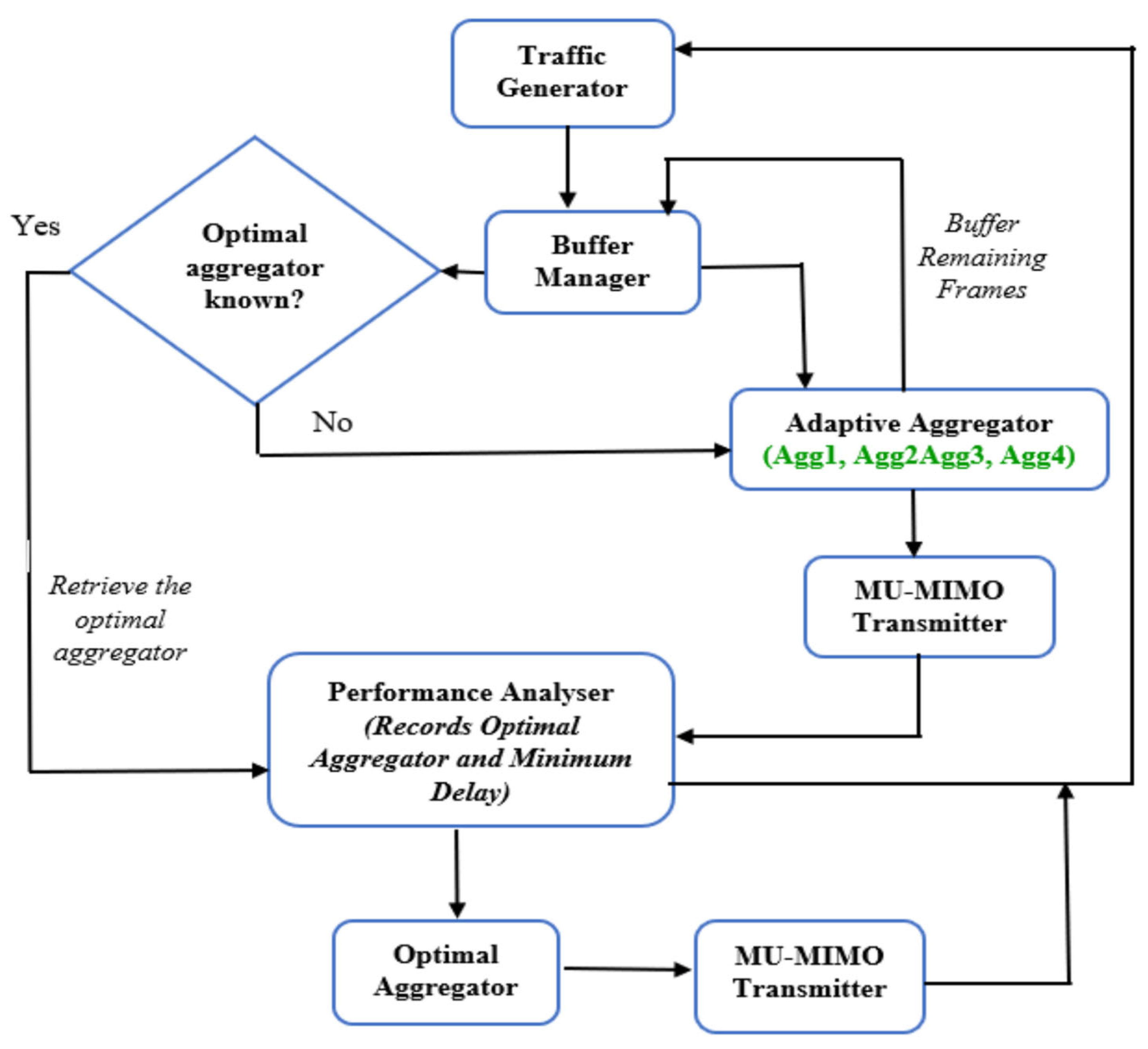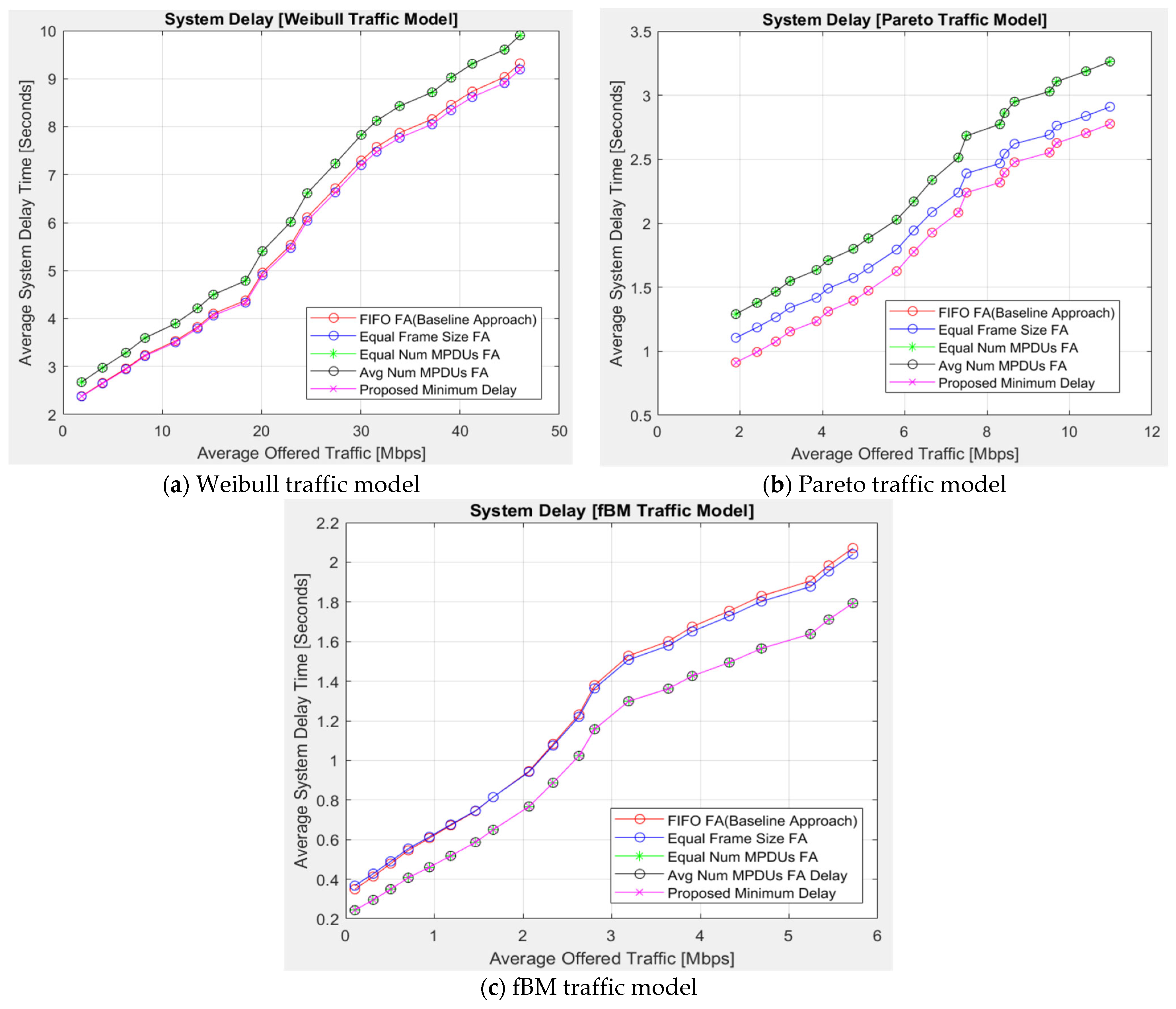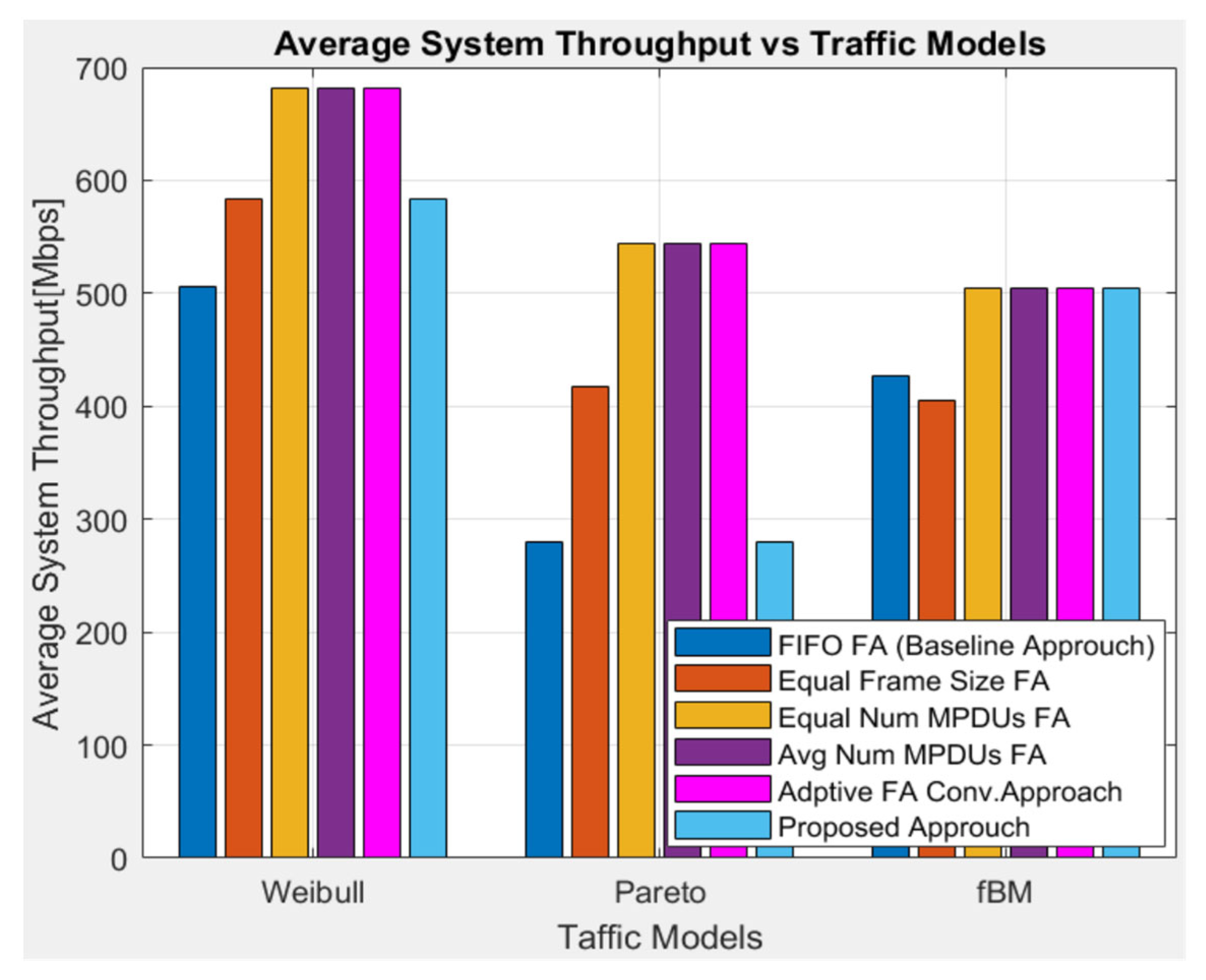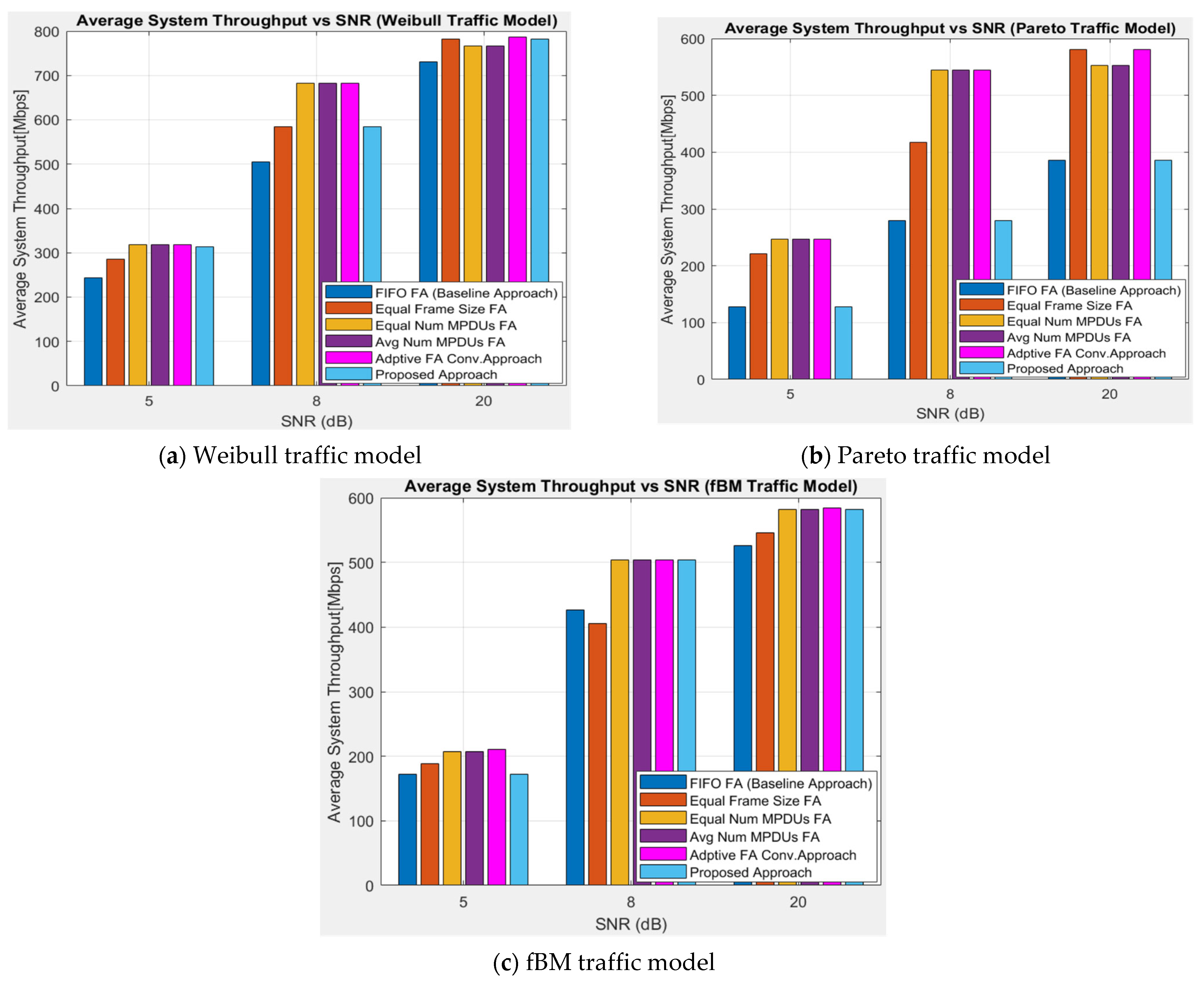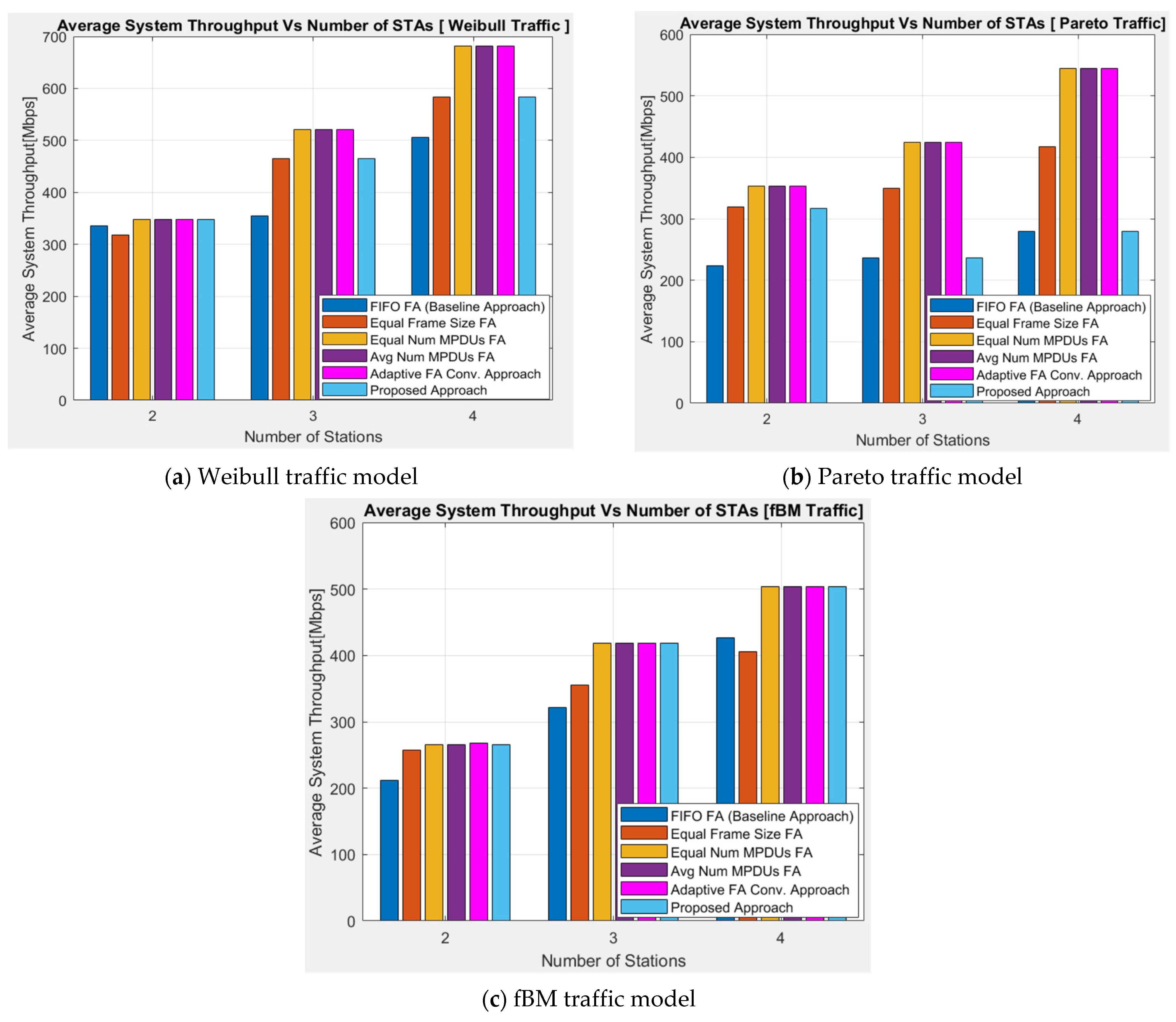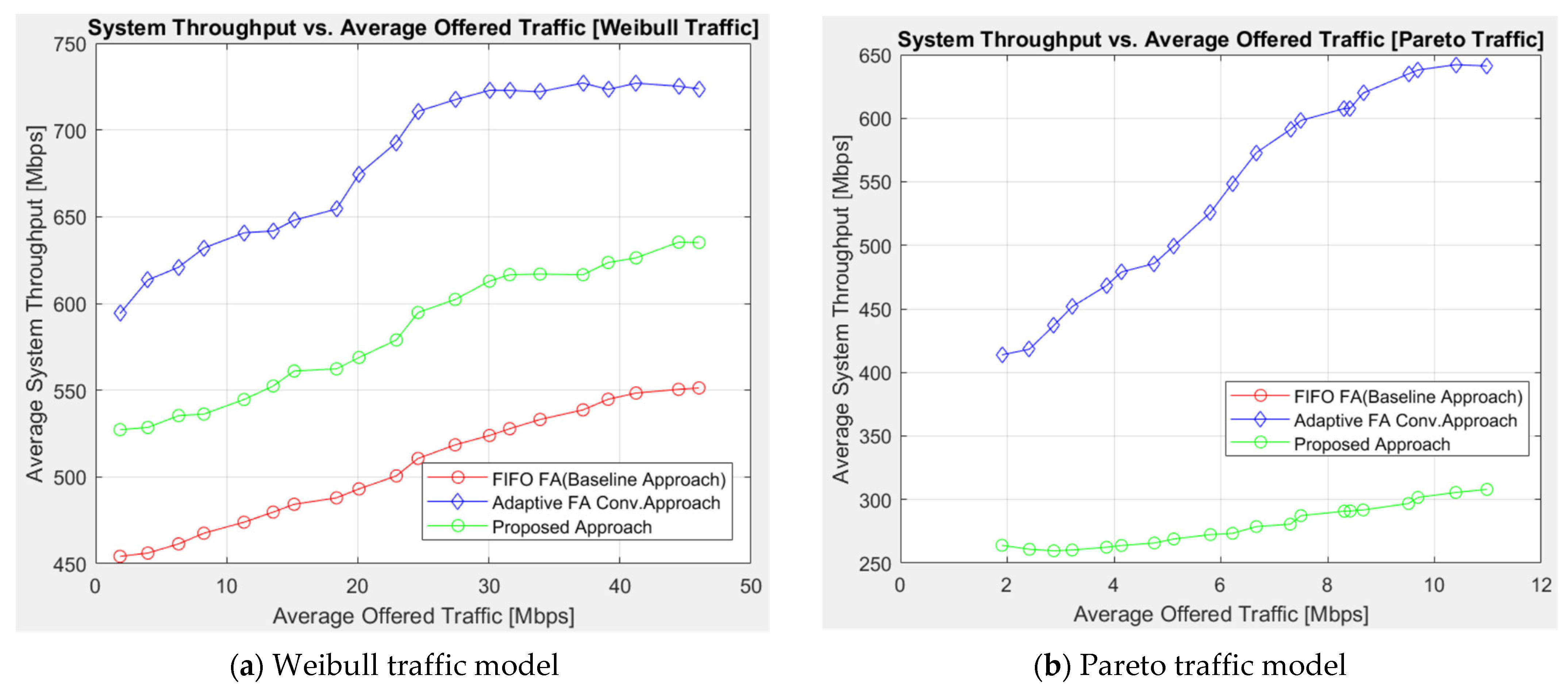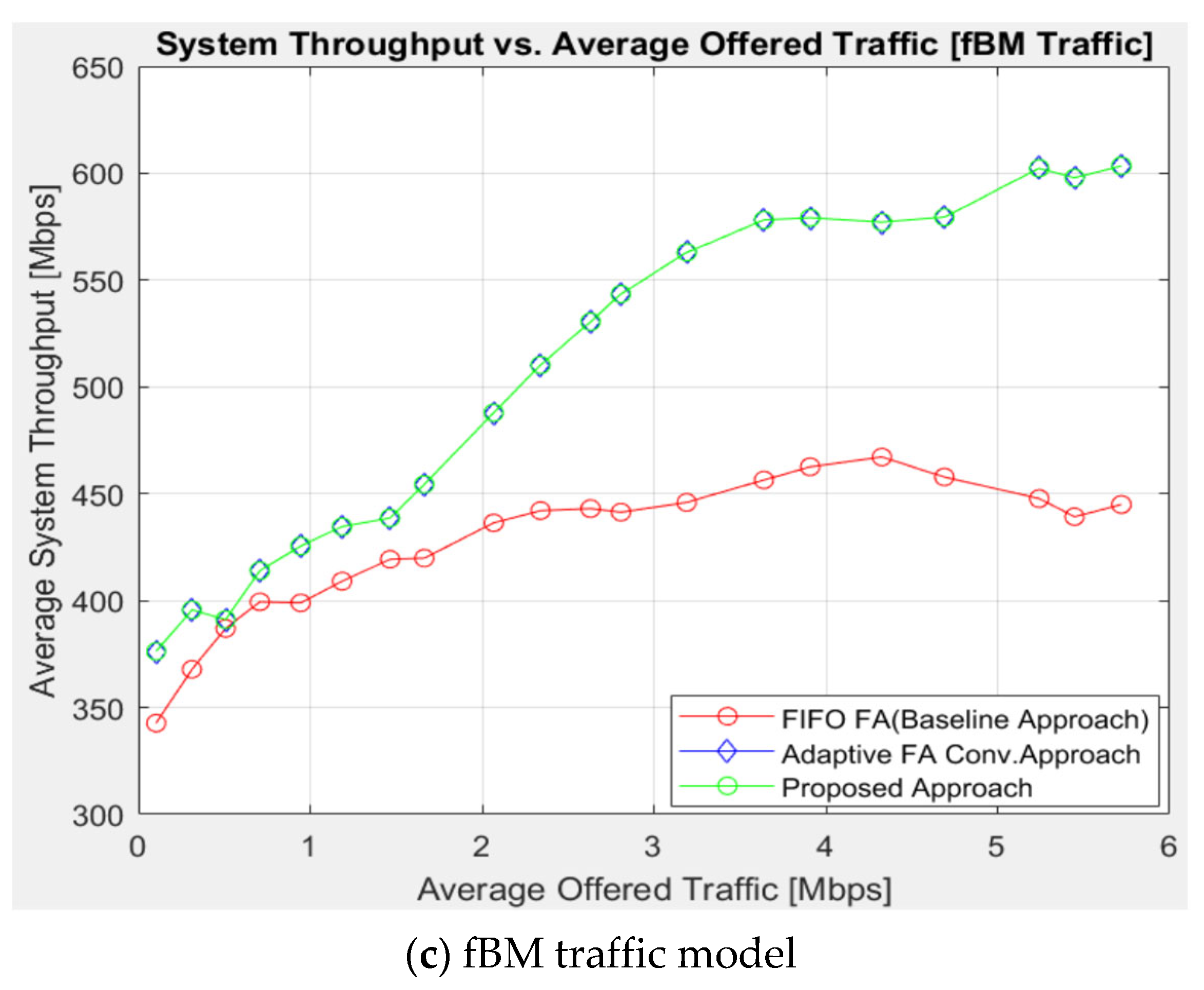1. Introduction
Due to the advancement of wireless technologies, IEEE 802.11-based networks are becoming more popular and different technologies have been introduced to improve throughput performance. Multiuser, multiple-input, multiple-output (MU-MIMO) is among the technologies at the physical layer introduced in the IEEE 802.11ac standard to accommodate the increasing demand for high data-transmission rates by allowing a single access point (AP) that supports simultaneous transmission for up to a maximum of eight users at a time [
1,
2]. This is one of the most crucial technologies that has driven wireless local area networks (WLANs) into the gigabit era. Moreover, the wireless medium has a high overhead in terms of bytes that can be higher than the actual payload. To amortize these overheads, which include the medium access control (MAC) and physical (PHY) headers, acknowledgments (ACK), backoff time, and interframe spacing, the standard also introduced a frame-aggregation scheme that has contributed to high data throughput by combining multiple frames, also known as MAC service data units (MSDUs), into a single transmission unit [
1]. The performance of WLAN depends on different performance factors at different layers of the network protocol stack, such as at the PHY and MAC layers. For instance, the frequency channel, modulation and coding schemes, transmitter power, etc., at the PHY layer; and the retry limit, frame size, contention window size, maximum number of backoffs, etc., at the MAC layer have a significant impact on the performance of WLAN. Optimizing these parameters would improve the system performance of WLAN. If a wireless frame size is large, a bit error can destroy the whole frame, thus the frame success rate decreases, and thus the throughput performance is degraded [
3]. On the other hand, if the frame size is shorter, the overhead frames such as MAC and PHY headers occupy a large portion of the transmitted frame and thus degrade the transmission efficiency [
3].
The IEEE 802.11 standard specifies a constant-length aggregation strategy regardless of the traffic pattern and channel conditions in the actual network. This contributes to the reduction in channel access overhead. However, utilizing the maximum aggregation size may not be optimal in all situations because it may lead to an increase in the delivery of error frames and retransmissions [
4]. However, both throughput and delay are the most important performance metrics that need to be considered in frame-aggregation algorithms [
5]. Frame aggregation allows protocol overhead to be reduced, thus it can significantly improve throughput performance, but this improvement will also have a related cost in terms of increasing the delay [
5,
6,
7]. The time for which more frames wait before transmission in a buffer is the main factor of delay when using frame-aggregation algorithms [
5,
6,
7,
8,
9]. Therefore, this indicates that there is a trade-off between increasing throughput and increasing delay. Network delay is an important performance characteristic of the IEEE 802.11 wireless network, and it is usually categorized into different parts such as processing delay, transmission delay, queue delay, and propagation delay [
5,
7]. In this study, queue delay and transmission delay were considered. Queue delay is defined as the queuing time of the first arrival packet waiting in the buffer [
7,
8]. In this study, it was computed by considering the arrival time of the first frame (i.e., the time from when it arrived at the AP’s buffer until the time it was begun to be transmitted) [
7,
8]. Transmission delay is defined as the time when a station begins to check the channel state (i.e., idle or busy) for transmitting a frame until it receives an ACK of the frame [
6]. Average minimum delay is defined as the average delay under saturation conditions [
5,
6]. Under the conditions of an unpredictable heterogeneous traffic pattern and channel conditions, different aggregation algorithms provide different performances in terms of throughput and delay. In addressing these challenges, this study proposed to realize the optimal system throughput of WLAN in a downlink MU-MIMO channel for minimizing system delay by employing a dynamic adaptive aggregation selection scheme.
Therefore, the main contribution of this paper was to propose an adaptive aggregation algorithm that attempted to achieve an optimal trade-off between maximizing throughput and minimizing delay. The proposed approach adopted different aggregation policies [
10] to adaptively select the optimal aggregation policy that maximized the system throughput while minimizing the cost of delay. Different test-case scenarios were considered such as channel error, traffic pattern, and number of competing stations. Through system-level simulation, the performance of the proposed approach was validated over the FIFO aggregation algorithm and earlier adaptive aggregation approaches [
11], which do not consider the issue of delay under the effects of heterogenous traffic patterns, channel conditions, and number of STAs for WLAN downlink MU-MIMO channels. To the best of our knowledge, this was the first attempt to exploit the trade-off between both maximizing throughputs and minimizing delay while considering the impact of queue delay and transmission delay in the WLAN downlink MU-MIMO channel. Moreover, this study addressed the challenges of heterogeneous traffic demand and channel conditions while considering a traffic mix of VoIP and video.
The rest of the paper is organized as follows. In
Section 2, we introduce related works on frame-aggregation schemes and the performance challenges of multiuser transmissions in the WLAN downlink MU-MIMO channel. A detailed problem description of the proposed approach is given in
Section 3. In
Section 4, the results and discussions are presented to evaluate the performance of the proposed approach under various channel conditions, traffic models, and number of stations. Finally, the conclusions are given in
Section 5.
3. Proposed Approach
This section proposes a frame-aggregation scheme that allows an adaptive trade-off between maximizing throughput and minimizing delay by employing a dynamic adaptive aggregation selection mechanism for the WLAN downlink MU-MIMO channel. In this study, the challenges of heterogenous traffic patterns, channel errors, and the number of stations, which severely affect the performances of both throughput and delay, were considered. Any improvement achieved by adopting aggregation experiences an increasing delay. Therefore, the adaptive aggregation mechanism is one of the methods to control the performance of throughput and delay.
This study proposed to enhance the performance of the adaptive aggregation algorithm in [
11] by considering the issues of queue delay and transmission delay, which have a significant impact when frame-aggregation algorithms are adopted. The main contribution of this study was to improve the system throughput of WLAN with the least cost in terms of a delay increase. Generating traffic was the first operation achieved by using Preto, Weibull, and fBM traffic models adopted from [
10] for the MAC service data unit (MSDU) data frames in bytes. According to our assumption, constant frame sizes of 100 bytes for a traffic mix of 75% VoIP and 1000 bytes for 25% video traffic [
10] were considered. All user frames were buffered in the AP, including the new arrival frame and remaining frames that were not selected for aggregation. Remaining frames could occur due to the target aggregate frame size determined by the type of aggregation policy employed and frames that remained in the buffer due to the maximum A-MPDU frame-size limitation specified in the IEEE 801.11ac standard [
10]. AP buffer frames as large as the maximum storage capacity of 50 MB were allowed. However, if the AP buffer was full, the reception of new frames was denied, and the AP continued with the output process until some space became free at the buffer.
Different aggregation algorithms experience different performances in terms of throughput and delay mainly due to unpredictable traffic patterns and channel conditions in the actual network. Thus, the different aggregation policies proposed in [
10] experience different performance in terms of both throughput and delay. For instance, FIFO FA allows a maximum frame-size aggregation as long as the maximum aggregate frame size allowed by IEEE 802.11, which improves the throughput. Moreover, it reduces the queue delay of frames before transmission. However, a longer frame size will incur a longer transmission delay. Equal Frame Size FA allows all streams to have an equal aggregation size while considering the station’s queue size. This approach always selects the smaller queue size to assemble the target aggregate frame size. Therefore, if the traffic is highly bursty; i.e., if the queue size of the stations has a high variation, the aggregation overhead will be higher due to shorter payload frame aggregation. However, on the contrary, the shorter frame-size aggregation could perform better in error-prone channel conditions [
11]. The Equal MPDUs Agg FA allows an equal number of aggregated frames to be assembled in all streams. Similarly, this aggregation policy is affected by the traffic pattern; i.e., if the traffic is highly bursty, the target aggregate frame size will be shorter, which degrades the throughput and likewise increases the queue delay due to remaining frames left in the buffer before transmission. The Avg Num MPDUs FA considers the average number of frames among streams to assemble the target aggregate frame size. This approach can perform better when the traffic variation among streams is bursty, but it also experiences a delay due to the remaining frames in the buffer. Therefore, this indicates that a trade-off exists between maximizing throughput and minimizing delay when adopting frame-aggregation algorithms due to traffic patterns and channel condition. This study addressed this trade-off by proposing an adaptive aggregation algorithm that allowed a dynamic adaptive aggregation selection scheme by adopting different aggregation policies (FIFO FA, Equal Frame Size FA, Equal MPDUs Agg FA, and Avg Num MPDUs FA) [
10]. The aim was to realize an optimal trade-off between maximizing throughput and minimizing delay.
Figure 1 shows a flowchart of the proposed adaptive aggregation algorithm while considering the delay.
As shown in
Figure 1, once the traffic was generated and buffered, the AP performed the optimal aggregation policy selection under the different channel conditions (SNR = 5, 8, or 20 dB), traffic models (Pareto, Weibull, or fBM), and number of STAs while considering a traffic mix of 75% VoIP and 25% video. Then, the aggregation manager aggregated the data frame of each user while employing the four different aggregation policies depicted in [
10], such as Agg1, Agg2, Agg3, and Agg4 in
Figure 1, which represented the FIFO FA (baseline approach), Equal Frame Size FA, Equal MPDUs Agg FA, and Avg Num MPDUs FA aggregation policies, respectively. Then, the aggregated data frames of each aggregation policy were transmitted one by one to the receiving STAs (receivers) using the MU-MIMO technique. The receiving stations received different aggregated frame sizes that were obtained using the different aggregation policies. Then, the performance analyzer in the AP evaluated the performance of each aggregation policy, determined which one provided the minimum system delay, and recorded the optimal aggregation policy and the corresponding minimum delay. This record was then utilized in future operations when a similar channel condition and traffic pattern and number of stations occurred in the system. Therefore, from all possible frame sizes obtained from the different aggregation policies, the optimal system frame size was the one obtained from the optimal aggregation policy with the minimum delay. However, if the AP determined the optimal aggregation policy with the given traffic pattern, channel condition, and number of competing stations by retrieving the performance analyzer, frame aggregation could be constructed by the optimal aggregator and the MU-MIMO transmission could be made promptly, as shown in the flowchart.
In this study, delay was defined as the average time to successfully transmit a data frame from the source station (AP) to the destination station, while the minimum average delay was the average delay under saturation conditions in the wireless network. As discussed, the aggregation process began after the arrival of a certain numbered frame in the buffer. Moreover, the different aggregation policies adopted different aggregation strategies when selecting frames for aggregation (FIFO FA (baseline approach), Equal Frame Size FA, Equal MPDUs Agg FA, and Avg Num MPDUs FA). Thus, in this study, we considered the queue delay while considering both the waiting delay and aggregation delay. Queue delay (
QDelay) was defined as the sum of time spent waiting for more packets to arrive (waiting delay) and waiting time for aggregation (aggregation delay), which was the amount of time frames waited in the buffer when they were not selected for aggregation. The frame-aggregation delay was the amount of time between the arrival time of the first frame in the buffer until the time it could start to be transmitted [
8]. Equations (1)–(3) illustrate how the queue delay was computed in this study. Both the waiting delay and aggregation delay in the equations considered the time difference between the arrival time of the old frame and just-arrived frames for
n number of stations in the downlink MU-MIMO channel streams. The maximum number of stations assumed in this study was 4.
Thus,
QDelay for each aggregation policy such as FIFO FA (baseline approach), Equal Frame Size FA, Equal MPDUs Agg FA, and Avg Num MPDUs FA was defined as shown in Equation (3):
where:
n is number of stations;
t is the tth simulation time;
is the arrival time of the last frame;
is the arrival time of the first frame;
is the aggregation delay of the last frame;
is the aggregation delay of the first frame.
The transmission delay (
) was defined as the time when a station began to check the channel state (i.e., idle or busy) for transmitting a frame until it received an ACK of the frame [
6]. The time required for completing a single MU-MIMO transmission by each of the aggregation policies (FIFO FA (baseline approach), Equal Frame Size FA, Equal MPDUs Agg FA, and Avg Num MPDUs FA) was determined by the transmission time of the longer frame, which was defined as
[
11], as shown in Equation (4):
Therefore, the average system delay for a single MU-MIMO transmission in different aggregation policies (FIFO FA (baseline approach), Equal Frame Size FA, Equal MPDUs Agg FA, and Avg Num MPDUs FA) was defined as the ratio of the sum of the queue delay and transmission delay and the number of stations, as illustrated in Equation (5):
where
n is number of stations in the network and
t is the
tth simulation time.
Finally, the optimal aggregation policy with the minimum system delay was obtained by comparing the different aggregation algorithms (FIFO FA (baseline approach), Equal Frame Size FA, Equal MPDUs Agg FA, and Avg Num MPDUs FA) using the performance analyzer, as illustrated in Equation (6):
Thus,
gave the minimum system delay and the index of the optimal aggregation policy
at time
t. It was assumed that the aggregation policies were arranged in the order of 1 to 4, respectively, for Agg1, Agg2, Agg3, and Agg4. Therefore, if the
, the minimum system delay was achieved by Agg1. Otherwise, if the
, it was Agg4. The system throughput was the average data rate at which the AP could successfully deliver to all receiving stations [
10,
11]. It was computed as the ratio of the sum of all the successful frame sizes of the system over the total channel transmission time.
5. Conclusions and Future Works
The release of the new IEEE 802.11 standards such as IEEE 802.11ax and IEEE 802.11ay, 5G technologies, and the massive amount of traffic with mixed types of applications generated in modern networks demand different network performance requirements in terms of maintaining some form of an optimal trade-off between maximizing throughput and minimizing delay. However, the majority of existing researchers only attempted to maximize the throughput or minimize the delay. Both the performance of throughput and delay can be affected by several factors such as heterogeneous traffic pattern, target aggregate frame size, channel condition, competing stations, etc. However, under the effects of uncertain conditions of heterogeneous traffic patterns and channel conditions in a network, determining the optimal target aggregate frame size is significant and can be controlled to manage both the throughput and delay. The main contribution of this paper was to propose an adaptive aggregation algorithm aiming to maximize the system throughput performance of a WLAN in the downlink MU-MIMO channel by maintaining the lowest cost in terms of increasing the system delay. Different aggregation algorithms such as FIFO FA, Equal Frame Size FA, Equal MPDUs Agg FA, and Avg Num MPDUs FA were adopted to achieve the dynamic adaptive aggregation selection scheme to realize an optimal trade-off between maximizing throughput and minimizing delay. The effects of channel conditions, heterogeneous traffic patterns for VoIP and video traffic applications, and number of stations were considered when evaluating the proposed approach. Through a simulation, the performance of the proposed approach was evaluated under various channel conditions, traffic patterns with a traffic mix of VoIP and video, and number of STAs. According to the results, the proposed approach achieved a significant performance in terms of both system throughput and system delay over the FIFO FA (baseline approach), and also achieved a better performance closest to the Adaptive FA Conv. approach, which only focuses on achieving the maximum throughput performance with a cost of maximum delay, than the nonadaptive FIFO FA (baseline approach).
Future work will extend the proposed adaptive aggregation approach to operate in real traffic scenarios. We will study the effects of different channel models such as Rayleigh and Rician on both uplink and downlink WLAN channels. Moreover, we will evaluate our approach on an experimental testbed.
